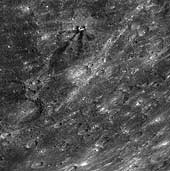|
COMETS EARTH JUPITER KUIPER BELT MARS MERCURY METEORITES NEPTUNE OORT CLOUD PLUTO SATURN SOLAR SYSTEM SPACE SUN URANUS VENUS ORDER PRINTS
PHOTO CATEGORIES SCIENCEVIEWS AMERICAN INDIAN AMPHIBIANS BIRDS BUGS FINE ART FOSSILS THE ISLANDS HISTORICAL PHOTOS MAMMALS OTHER PARKS PLANTS RELIGIOUS REPTILES SCIENCEVIEWS PRINTS
|
Related Documents
Download Options
Date Acquired: October 6, 2008 When a meteoroid strikes the surface of a planet, material from the surface is ejected outward at high velocity, often creating rays that extend over distances far greater than the size of the crater formed by the impact. During MESSENGER's second Mercury flyby, MDIS captured images of impressive rays on Mercury, such as the ejecta prominent around Kuiper crater and the extensive ray system associated with a newly imaged crater in Mercury's northern latitudes. In both of those examples, the rays appear bright, which is characteristic of freshly pulverized rock and indicates that the rays are younger than much of Mercury's surface. In contrast, in the upper portion of this NAC image, a set of dark rays is seen emerging from a small crater. Dark rays are rare on Mercury, but other occurrences have been identified, such as at Mozart crater (imaged during MESSENGER's first Mercury flyby). Mozart crater is interpreted to have excavated dark material from depth during the impact event, creating dark streamers. The dark rays from the crater shown here may have a similar origin, and color imaging from the Wide Angle Camera (WAC) gathered during the flyby is being used to explore the nature of these unusual dark rays further. Credit: NASA/Johns Hopkins University Applied Physics Laboratory/Carnegie Institution of Washington |
